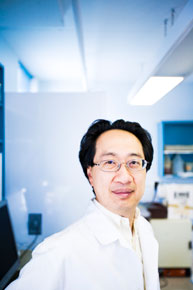67 years on the cutting edge
Making history at the Division of Endocrinology and Metabolism

Dr. Simon Wing
Claudio Calligaris
When McGill's Research Institute of Endocrinology was founded in 1941, deoxyribonucleic acid – or DNA – was still unknown, no one had ever heard of a receptor cell and genetic engineering was an impossible fantasy. Sixty-seven years later, the impossible is business as usual at the Institute's successor, the sprawling Division of Endocrinology and Metabolism.
In 2007 and 2008, the Division repeatedly made the news as affiliated researchers Dr. Robert Sladek and Dr. Constantin Polychronakos pioneered a breakthrough technique to indentify the genetic risk-factors for type 2 diabetes, based on a huge study of the entire human genome. In 2008, a follow-up study using the same data identified a DNA sequence that controls the variability of blood glucose levels in non-diabetics, a highly significant discovery because high blood glucose levels in otherwise healthy people often are indications of heart disease and higher mortality rates.
"We used a totally new concept and technology to look for the genes," Polychronakos said. "It worked very successfully and our findings are proof of principle that these approaches can be used to dissect the genetic component of other complex diseases and, eventually, other complex human traits."
"This brings us ever-closer to the idea of 'personalized medicine,' " Sladek added. "Eventually, we might be able to customize treatment to an individual's unique genetic structure."
These breakthroughs are the latest links in a chain of innovation that extends back to the earliest days of endocrine research at McGill, said Dr. Simon Wing, director of the Division of Endocrinology and Metabolism.
Dr. James Bertram Collip was already known as one of the four co-discoverers of insulin when he was recruited to McGill in 1928. While at the University, serving first as Chair of the Department of Biochemistry and later as the first Director of the Research Institute of Endocrinology, Collip refined the techniques he had developed to isolate and purify insulin and used them to identify hormones secreted by the pituitary gland.
In the 1960s and '70s, Dr. Henry Friesen, director of the Division's Polypeptide Lab, became the first researcher to successfully purify the hormone prolactin, which stimulates milk production in humans. He later developed a simple blood test which permitted thousands of people with prolactin-related reproductive disorders to become parents. Friesen later left McGill for a post at the University of Manitoba, and was later instrumental in establishing the Canadian Institutes for Health Research (CIHR), the federal funding agency which provided more than $35.5 million in grants to more than 80 McGill researchers in 2007-08 alone.
Dr. Beverly Murphy, Emeritus Professor in obstetrics and gynecology, first taught at McGill in 1964 and served for 20 years as senior obstetrician and gynecologist at the Montreal General Hospital, where she directed the Reproductive Physiology Unit from 1972 to 1994. She is best known for developing the first practical test for the measurement of the thyroid hormone thyroxine, an early precursor of the radiolabel assay, which became a standard test in the field for many years. Her paper on measuring thyroid hormone was one of the 100 most-cited papers in 1980 and she was one of only 27 women listed among the 1,000 most-cited contemporary scientists a year later. Her early work on the stress hormone cortisol continues to be cited decades later.
In the late 1970s and 1980s, Dr. Barry Posner and Dr. John Bergeron used the then state-of-the-art technique of radiolabelling – tracking a substance through the body through the use of mildly radioactive radionuclides – to identify hormone receptors in the human brain. They proved for the first time that there were insulin receptors in the brain and not just in the pancreas, which led to later breakthroughs on insulin's role in appetite.
"Their group was one of the first, again using the latest available technologies and methods, in detecting and following receptors," Wing explained. "They were able to show that once they bind with the hormone, receptors for hormones like insulin actually get taken inside the cell. They are able to exert some of their effects only because they are inside."
"We have a long history," Wing said, "of making leading-edge discoveries based on the use of new technologies as soon as they become available."

